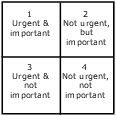Most business books are like your mom’s Thanksgiving leftovers — it’s the same old turkey no matter how you recycle it. These titles, however, are gems – Big Ideas that can transform your business and get you through your day less stress and more accomplishment.
1) Mind like water.
Martial arts practitioners have given us the concept of a “mind like water” – a mind that’s perfectly ready for whatever happens next. David Allen is a personal productivity expert who understands how hard this state is to achieve for business leaders who constantly juggle the incredibly important and the incredibly trivial – often before lunch. We all feel as if our heads are so full of to-do items and ideas that we can’t hear ourselves think sometimes, right?
Allen’s developed techniques for clearing your head of all the zillions of endless to-do items that chase around in our heads, plaguing almost all of us. His ideas won’t do the actual work for you, but they will get you past the constant fear that you’re dropping balls left and right, thus freeing your mind for productive activity.
He also has specific approaches that we’ve personally found invaluable for managing your time when your priorities constantly shift throughout the day based on incoming demands from customers, bosses, coworkers, etc.
Find out more about his first book, Getting Things Done: The Art of Stress-Free Productivity. (His second book, Ready for Anything: 52 Productivity Principles is really only for folks who have read and absorbed the first one.)
2) Urgent & important.
For us, this is the big takeaway concept from the famous 7 Habits of Highly Effective People, by Stephen Covey.
Covey’s time management matrix:
The basic idea is that it’s easy to spend all your time firefighting in Quadrants 1 (a furious customer) and 3 (doing work yourself that you could and should have delegated). Dallying in Quadrant 4 (say, cleaning up your hard disk or taking an inordinate amount of time to pick the colors in a new logo) is another productivity killer.
The unfortunate result is very little time spent in Quadrant 2, doing important work that isn’t urgent. Why unfortunately? Because this work is often what gives your business a strong long-term foundation – for example, planning how you can fully capitalize on a new product or thinking about how you would handle the sudden departure of a key employee.
Covey’s also written a second book, First Things First. Worth checking out if “Seven Habits” really struck a chord with you.
3) Truth is good.
We’ve noticed over the years that many businesspeople will spend more energy to dodge a painful truth than it would take to confront it head-on. It’s far better to acknowledge what’s true, regardless of how you feel about it, and then get on with the business of addressing it.
Just a few examples: not telling employees promptly about bad news, avoiding admitting a mistake to a ticked-off client, shifting a problem employee from one job to another, nodding up and down when you know the general manager’s plan is doomed to failure, being unwilling to ask for help when you can tell you’re in over your head.
No suggested reading on this one — just food for thought.
4) The ultimate question.
This idea is so powerful that we featured it in an article, “The Best Customer Loyalty Metric For Wellness Businesses.”
Fred Reichheld, a customer loyalty expert and author of The Ultimate Question: Driving Good Profits has boiled down years of thinking about how to measure customer loyalty into this single, crucial question. He also explores “good profits” and “bad profits”, often a concern for health and wellness businesses.
We suggest starting with The Ultimate Question, mostly because it’s got immediately useful ideas.
Then try his earlier book, The Loyalty Effect: The Hidden Force…, which is more big-picture and provides great food for thought. He’s got some amazingly original insights into why customers are and aren’t loyal to businesses. For example, he points out that sales and marketing costs are going up while customer service costs are going down in almost every business.
Coincidence? Absolutely not. If we all collectively spent half the effort to KEEP customers that we do to get them in the first place, our businesses would be much healthier.
5) Don’t make me think.
When you make your next Starbucks run, take Steve Krug’s Don’t Make Me Think: A Common Sense Approach to Web Usability. He tells you how to design a website that’s actually friendly and welcoming to customers. This is not a technical book or a graphic design book in any way, shape or form. Instead, it’s a book about how to make your website genuinely useful to your customers and therefore your business.
It’s short and sweet, uses big print and funny cartoons, plus TONS of examples, with the good and the bad spelled out in detail.
Many health and wellness websites provide potential customers with a poor introduction to your business. We practically guarantee you’ll finish this book with a laundry list of ideas for improving the usability of your site.
The first edition is still available at a higher price, but we recommend the second for fresher examples and even clearer explanations, plus two new sections.
6) Ageless marketing.
If you want to attract customers of all ages, focus on their values, not their chronological age. That’s the key message in Ageless Marketing: Strategies for Reaching the Hearts and Minds…, by David Wolfe and Robert Snyder. Marketing based on age-related stereotypes of potential customers often misses the mark and can even alienate them.
If you read nothing else in this book, read pages 166 – 177 for the lists of different values held by those aged 45 to 61 and those over 62, plus an explanation of how value-based marketing can simultaneously work for someone who’s, say, 45 and someone who’s 65.
7) Triple bottom line.
The big idea here is that businesses should evaluate their performance against three goals: people, planet, and profit. In other words, it’s not enough to make a financial profit. You also have to consider the immediate and long-term community and environmental consequences of your business activities and decisions.
This concept’s not entirely academic – for example, the Australian government provides guidelines for reporting on this “triple bottom-line” of community impact, environmental impact and financial profit.
As an entrepreneur, it’s easy to focus on nothing but the day-to-day financial survival of your business. It’s healthy to step back now and then and think about the really big picture, though.
A good place to start doing just that is with “The Triple Bottom Line: How Today’s Best-Run Companies Are Achieving Economic, Social and Environmental Success — and How You Can Too, by Andrew Savitz and Karl Weber.



